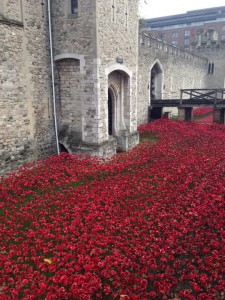
It’s Remembrance Day and this year the 11th November is more poignant than before as 2014 marks 100 years since the start of WW1. It was the conclusion of this conflict which created Remembrance Day marking the official end at the eleventh hour on the eleventh day on the eleventh month in 1918.
Every Remembrance Sunday, the Cenotaph Parade runs through Whitehall to remember those killed in conflict. However, this year Londoners have been able to remember and pay their respects from 5th August as 888,246 ceramic poppies have progressively filled the moat of the Tower of London.
I was late to the party and didn’t manage to visit ‘The Poppies’ until late October. I was also lucky as I arrived early (there are some benefits to being regularly woken at 5.30am) so could take in the view without too much jostling.
I have never lost a friend or family member in conflict so it’s hard for me to appreciate the feelings of loss and sorrow. ‘The poppies’ did help me to appreciate the scale of the loss of life in WW1, as each flower represents a British fatality during the war. The flowers cover such a huge area (it normally takes about 10 minutes to walk around the whole moat) you are left with the impression of a sea of red as if blood is flowing through the dry moat. Shelia Hancock has said the poppies should be mown down and left shattered to really show the sacrifice of those who lost their lives and stop viewers romanticising the loss of life.
I am no supporter of war or conflict and I’m not sure I believe that ‘Dulce et decorum est pro patria mori’ is true but I found the instillation very moving and a fitting tribute to those who fought bravely for their country.
